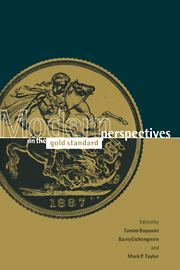Book contents
- Frontmatter
- Contents
- List of figures
- List of tables
- Notes on the contributors
- I Introduction
- II Operation of the gold standard
- III Adjustment mechanisms
- IV Monetary issues
- V Exchange rate behavior
- 11 The dollar/pound real exchange rate and fiscal policy during the gold standard period
- 12 Exchange rate dynamics and monetary reforms: theory and evidence from Britain's return to gold
- VI Conclusions
- Index
11 - The dollar/pound real exchange rate and fiscal policy during the gold standard period
Published online by Cambridge University Press: 05 November 2011
- Frontmatter
- Contents
- List of figures
- List of tables
- Notes on the contributors
- I Introduction
- II Operation of the gold standard
- III Adjustment mechanisms
- IV Monetary issues
- V Exchange rate behavior
- 11 The dollar/pound real exchange rate and fiscal policy during the gold standard period
- 12 Exchange rate dynamics and monetary reforms: theory and evidence from Britain's return to gold
- VI Conclusions
- Index
Summary
Introduction
More than a century has passed since the widespread adoption of the gold standard in 1879 and almost 80 years stand between its demise at the beginning of World War I and the present day. Economists look back to the gold standard period as a time when international markets in goods and capital operated efficiently and effectively. This view has served to make the gold standard period a benchmark for studying the experience of the interwar period or the post-World War II period with respect to issues such as international integration and international policy coordination.
The gold standard period has also come to serve as a benchmark for exchange rate experience since it was largely characterized by stable nominal exchange rates. For example, the British pound was worth 4.86 US dollars during the entire 35 years of the gold standard while the pound was devalued twice against the dollar during the shorter Bretton Woods era. There was also relative stability in the real exchange rate between the United States and United Kingdom during the gold standard period as compared to other times. The bilateral dollar/pound real exchange rate fluctuated within a range of about 20 percent during the 35 years of the gold standard and its level a few years after the resumption of the gold standard by the United States was very close to its level at the outset of World War I.
- Type
- Chapter
- Information
- Modern Perspectives on the Gold Standard , pp. 309 - 340Publisher: Cambridge University PressPrint publication year: 1997



